Family Genogram: Analyzing Derick Miller's Family Dynamics and History
VerifiedAdded on 2021/04/21
|8
|1864
|228
Report
AI Summary
This report presents an analysis of Derick Miller's family genogram, examining the complex family dynamics, relationships, and psychological factors influencing his life. The genogram reveals a history of divorces, unsuccessful marriages, strained relationships, and instances of abuse and neglect across three generations. The analysis explores the impact of these factors on Derick's development, including the influence of age-normative, history-normative, and non-normative influences. The report further applies developmental theories, such as Freud's Psychosexual Theory, Bowlby's Attachment Theory, and Bandura's Social Learning Theory, to understand how childhood experiences and observations shaped Derick's behavior and relationships. The study highlights the importance of genograms in understanding family history, identifying potential risks, and recognizing patterns of behavior that can affect an individual's well-being. The conclusion emphasizes the significance of genograms in family therapy for explaining family dynamics and the underlying causes of disruptions, illnesses, and relationships within a family.
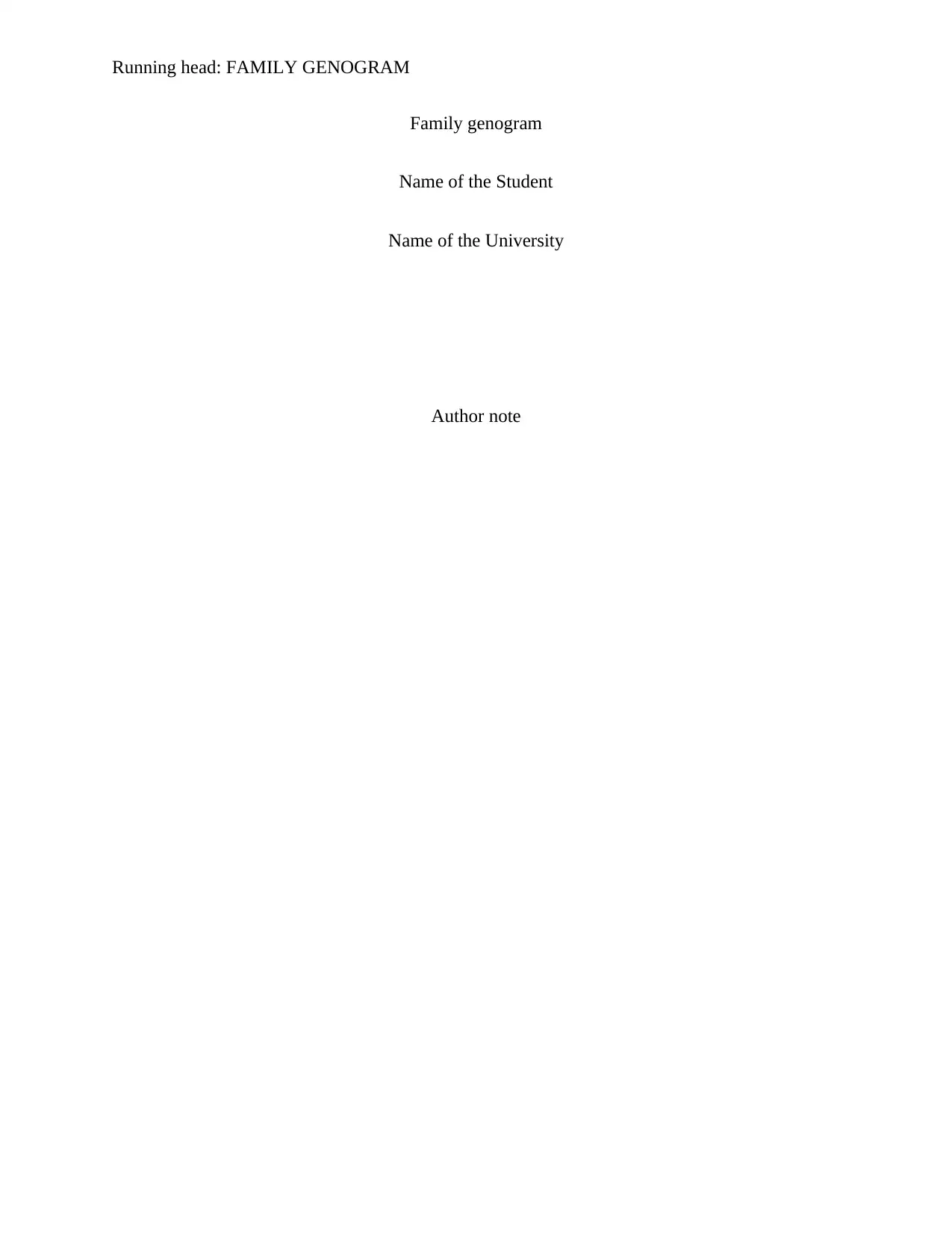
Running head: FAMILY GENOGRAM
Family genogram
Name of the Student
Name of the University
Author note
Family genogram
Name of the Student
Name of the University
Author note
Paraphrase This Document
Need a fresh take? Get an instant paraphrase of this document with our AI Paraphraser
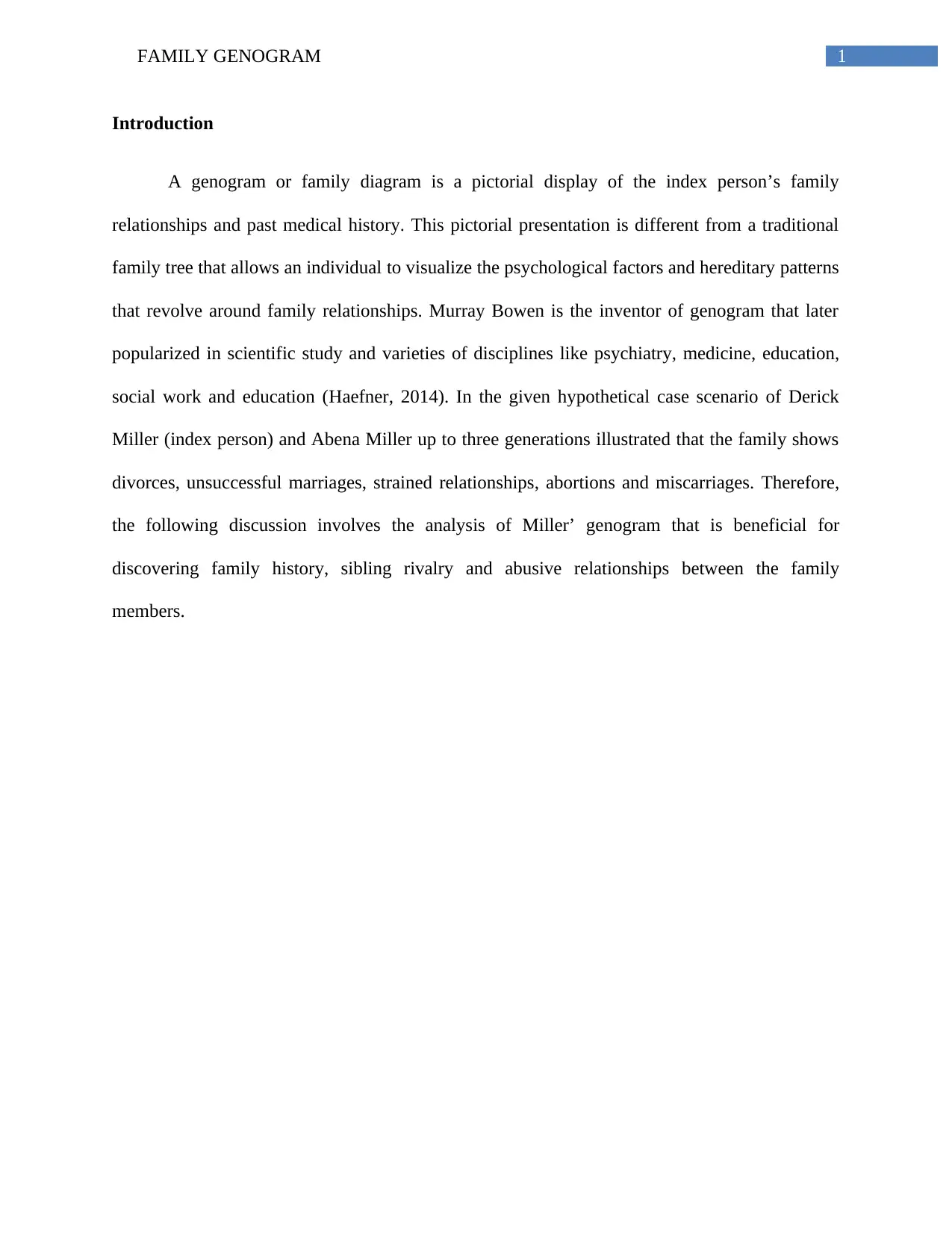
1FAMILY GENOGRAM
Introduction
A genogram or family diagram is a pictorial display of the index person’s family
relationships and past medical history. This pictorial presentation is different from a traditional
family tree that allows an individual to visualize the psychological factors and hereditary patterns
that revolve around family relationships. Murray Bowen is the inventor of genogram that later
popularized in scientific study and varieties of disciplines like psychiatry, medicine, education,
social work and education (Haefner, 2014). In the given hypothetical case scenario of Derick
Miller (index person) and Abena Miller up to three generations illustrated that the family shows
divorces, unsuccessful marriages, strained relationships, abortions and miscarriages. Therefore,
the following discussion involves the analysis of Miller’ genogram that is beneficial for
discovering family history, sibling rivalry and abusive relationships between the family
members.
Introduction
A genogram or family diagram is a pictorial display of the index person’s family
relationships and past medical history. This pictorial presentation is different from a traditional
family tree that allows an individual to visualize the psychological factors and hereditary patterns
that revolve around family relationships. Murray Bowen is the inventor of genogram that later
popularized in scientific study and varieties of disciplines like psychiatry, medicine, education,
social work and education (Haefner, 2014). In the given hypothetical case scenario of Derick
Miller (index person) and Abena Miller up to three generations illustrated that the family shows
divorces, unsuccessful marriages, strained relationships, abortions and miscarriages. Therefore,
the following discussion involves the analysis of Miller’ genogram that is beneficial for
discovering family history, sibling rivalry and abusive relationships between the family
members.
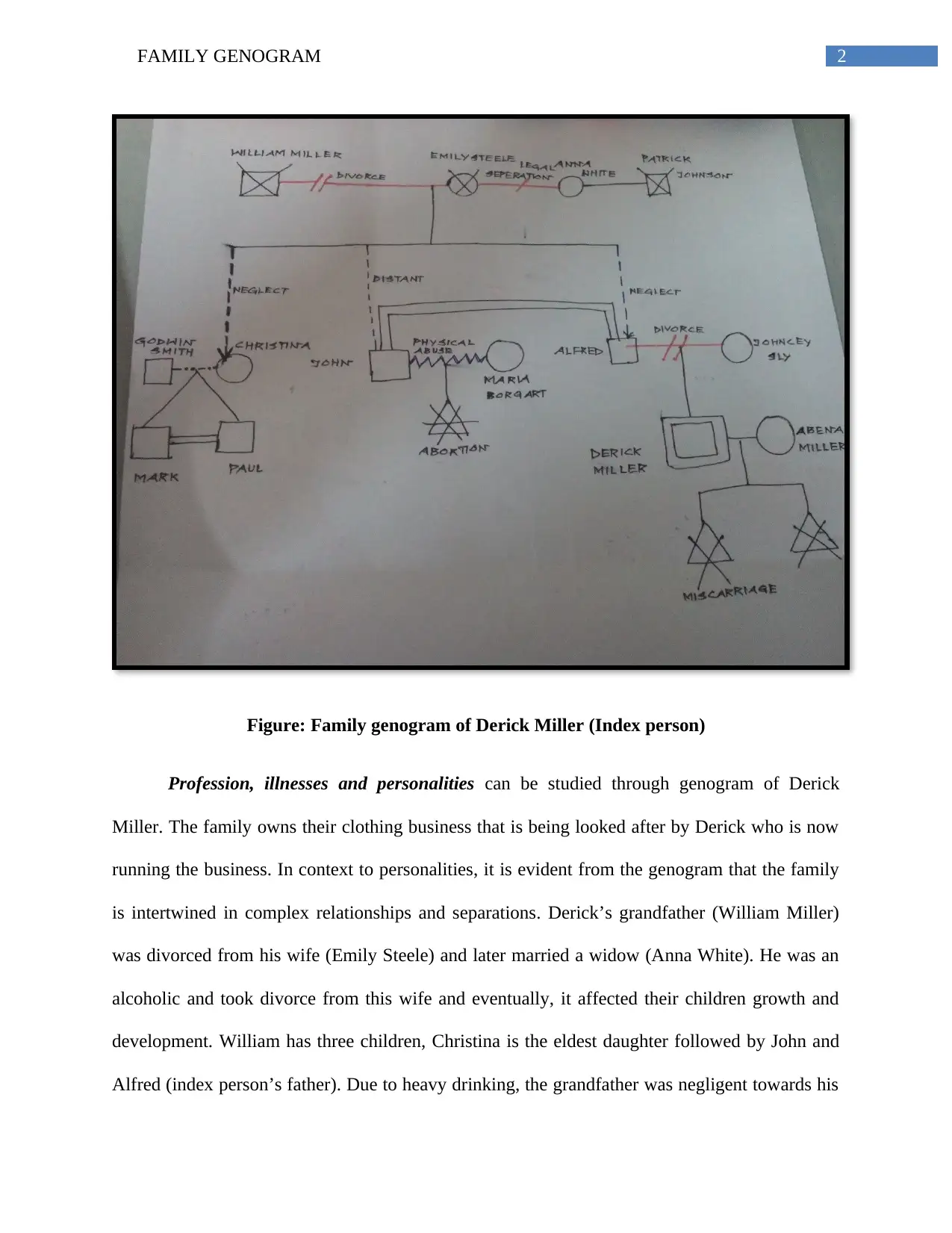
2FAMILY GENOGRAM
Figure: Family genogram of Derick Miller (Index person)
Profession, illnesses and personalities can be studied through genogram of Derick
Miller. The family owns their clothing business that is being looked after by Derick who is now
running the business. In context to personalities, it is evident from the genogram that the family
is intertwined in complex relationships and separations. Derick’s grandfather (William Miller)
was divorced from his wife (Emily Steele) and later married a widow (Anna White). He was an
alcoholic and took divorce from this wife and eventually, it affected their children growth and
development. William has three children, Christina is the eldest daughter followed by John and
Alfred (index person’s father). Due to heavy drinking, the grandfather was negligent towards his
Figure: Family genogram of Derick Miller (Index person)
Profession, illnesses and personalities can be studied through genogram of Derick
Miller. The family owns their clothing business that is being looked after by Derick who is now
running the business. In context to personalities, it is evident from the genogram that the family
is intertwined in complex relationships and separations. Derick’s grandfather (William Miller)
was divorced from his wife (Emily Steele) and later married a widow (Anna White). He was an
alcoholic and took divorce from this wife and eventually, it affected their children growth and
development. William has three children, Christina is the eldest daughter followed by John and
Alfred (index person’s father). Due to heavy drinking, the grandfather was negligent towards his
⊘ This is a preview!⊘
Do you want full access?
Subscribe today to unlock all pages.

Trusted by 1+ million students worldwide
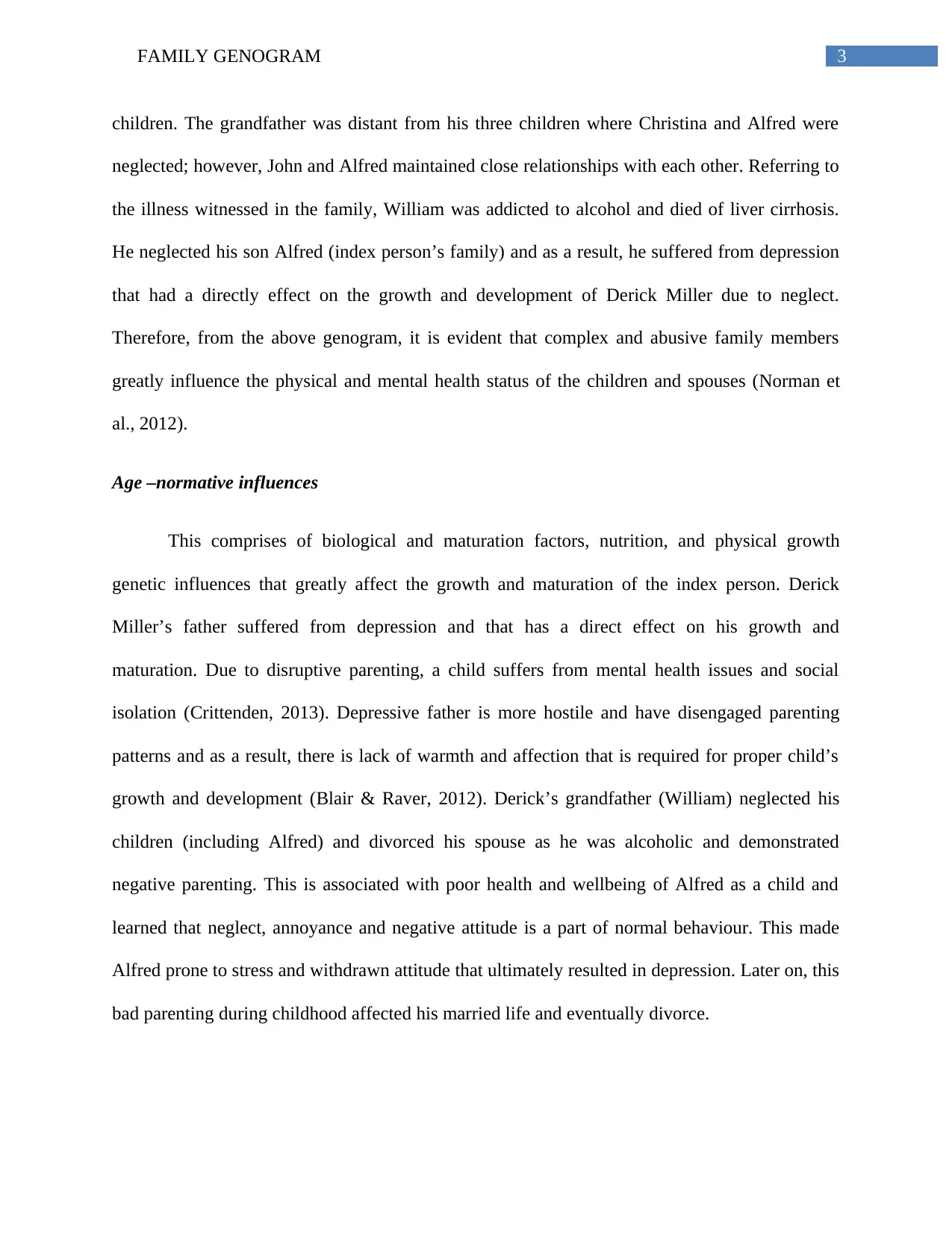
3FAMILY GENOGRAM
children. The grandfather was distant from his three children where Christina and Alfred were
neglected; however, John and Alfred maintained close relationships with each other. Referring to
the illness witnessed in the family, William was addicted to alcohol and died of liver cirrhosis.
He neglected his son Alfred (index person’s family) and as a result, he suffered from depression
that had a directly effect on the growth and development of Derick Miller due to neglect.
Therefore, from the above genogram, it is evident that complex and abusive family members
greatly influence the physical and mental health status of the children and spouses (Norman et
al., 2012).
Age –normative influences
This comprises of biological and maturation factors, nutrition, and physical growth
genetic influences that greatly affect the growth and maturation of the index person. Derick
Miller’s father suffered from depression and that has a direct effect on his growth and
maturation. Due to disruptive parenting, a child suffers from mental health issues and social
isolation (Crittenden, 2013). Depressive father is more hostile and have disengaged parenting
patterns and as a result, there is lack of warmth and affection that is required for proper child’s
growth and development (Blair & Raver, 2012). Derick’s grandfather (William) neglected his
children (including Alfred) and divorced his spouse as he was alcoholic and demonstrated
negative parenting. This is associated with poor health and wellbeing of Alfred as a child and
learned that neglect, annoyance and negative attitude is a part of normal behaviour. This made
Alfred prone to stress and withdrawn attitude that ultimately resulted in depression. Later on, this
bad parenting during childhood affected his married life and eventually divorce.
children. The grandfather was distant from his three children where Christina and Alfred were
neglected; however, John and Alfred maintained close relationships with each other. Referring to
the illness witnessed in the family, William was addicted to alcohol and died of liver cirrhosis.
He neglected his son Alfred (index person’s family) and as a result, he suffered from depression
that had a directly effect on the growth and development of Derick Miller due to neglect.
Therefore, from the above genogram, it is evident that complex and abusive family members
greatly influence the physical and mental health status of the children and spouses (Norman et
al., 2012).
Age –normative influences
This comprises of biological and maturation factors, nutrition, and physical growth
genetic influences that greatly affect the growth and maturation of the index person. Derick
Miller’s father suffered from depression and that has a direct effect on his growth and
maturation. Due to disruptive parenting, a child suffers from mental health issues and social
isolation (Crittenden, 2013). Depressive father is more hostile and have disengaged parenting
patterns and as a result, there is lack of warmth and affection that is required for proper child’s
growth and development (Blair & Raver, 2012). Derick’s grandfather (William) neglected his
children (including Alfred) and divorced his spouse as he was alcoholic and demonstrated
negative parenting. This is associated with poor health and wellbeing of Alfred as a child and
learned that neglect, annoyance and negative attitude is a part of normal behaviour. This made
Alfred prone to stress and withdrawn attitude that ultimately resulted in depression. Later on, this
bad parenting during childhood affected his married life and eventually divorce.
Paraphrase This Document
Need a fresh take? Get an instant paraphrase of this document with our AI Paraphraser
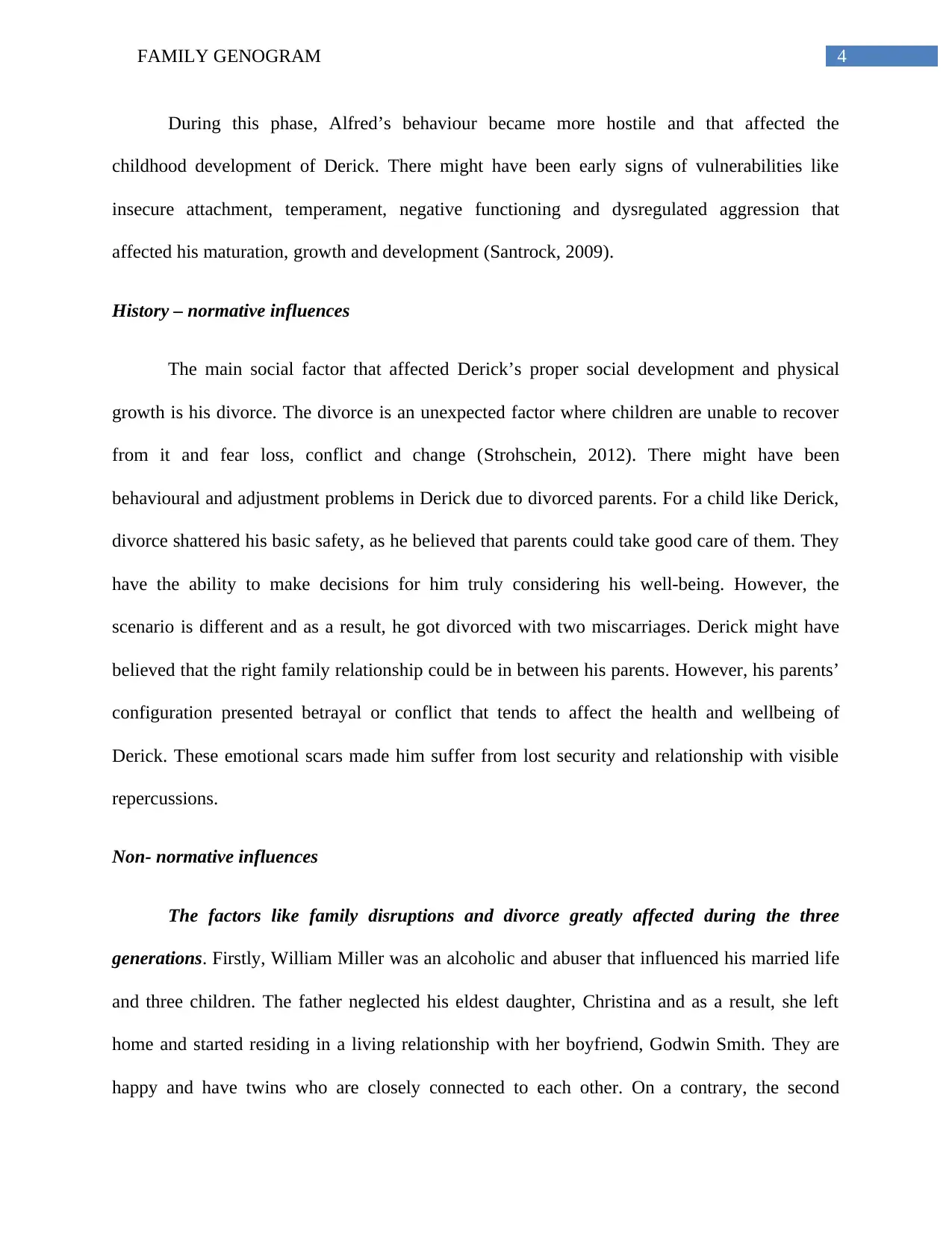
4FAMILY GENOGRAM
During this phase, Alfred’s behaviour became more hostile and that affected the
childhood development of Derick. There might have been early signs of vulnerabilities like
insecure attachment, temperament, negative functioning and dysregulated aggression that
affected his maturation, growth and development (Santrock, 2009).
History – normative influences
The main social factor that affected Derick’s proper social development and physical
growth is his divorce. The divorce is an unexpected factor where children are unable to recover
from it and fear loss, conflict and change (Strohschein, 2012). There might have been
behavioural and adjustment problems in Derick due to divorced parents. For a child like Derick,
divorce shattered his basic safety, as he believed that parents could take good care of them. They
have the ability to make decisions for him truly considering his well-being. However, the
scenario is different and as a result, he got divorced with two miscarriages. Derick might have
believed that the right family relationship could be in between his parents. However, his parents’
configuration presented betrayal or conflict that tends to affect the health and wellbeing of
Derick. These emotional scars made him suffer from lost security and relationship with visible
repercussions.
Non- normative influences
The factors like family disruptions and divorce greatly affected during the three
generations. Firstly, William Miller was an alcoholic and abuser that influenced his married life
and three children. The father neglected his eldest daughter, Christina and as a result, she left
home and started residing in a living relationship with her boyfriend, Godwin Smith. They are
happy and have twins who are closely connected to each other. On a contrary, the second
During this phase, Alfred’s behaviour became more hostile and that affected the
childhood development of Derick. There might have been early signs of vulnerabilities like
insecure attachment, temperament, negative functioning and dysregulated aggression that
affected his maturation, growth and development (Santrock, 2009).
History – normative influences
The main social factor that affected Derick’s proper social development and physical
growth is his divorce. The divorce is an unexpected factor where children are unable to recover
from it and fear loss, conflict and change (Strohschein, 2012). There might have been
behavioural and adjustment problems in Derick due to divorced parents. For a child like Derick,
divorce shattered his basic safety, as he believed that parents could take good care of them. They
have the ability to make decisions for him truly considering his well-being. However, the
scenario is different and as a result, he got divorced with two miscarriages. Derick might have
believed that the right family relationship could be in between his parents. However, his parents’
configuration presented betrayal or conflict that tends to affect the health and wellbeing of
Derick. These emotional scars made him suffer from lost security and relationship with visible
repercussions.
Non- normative influences
The factors like family disruptions and divorce greatly affected during the three
generations. Firstly, William Miller was an alcoholic and abuser that influenced his married life
and three children. The father neglected his eldest daughter, Christina and as a result, she left
home and started residing in a living relationship with her boyfriend, Godwin Smith. They are
happy and have twins who are closely connected to each other. On a contrary, the second
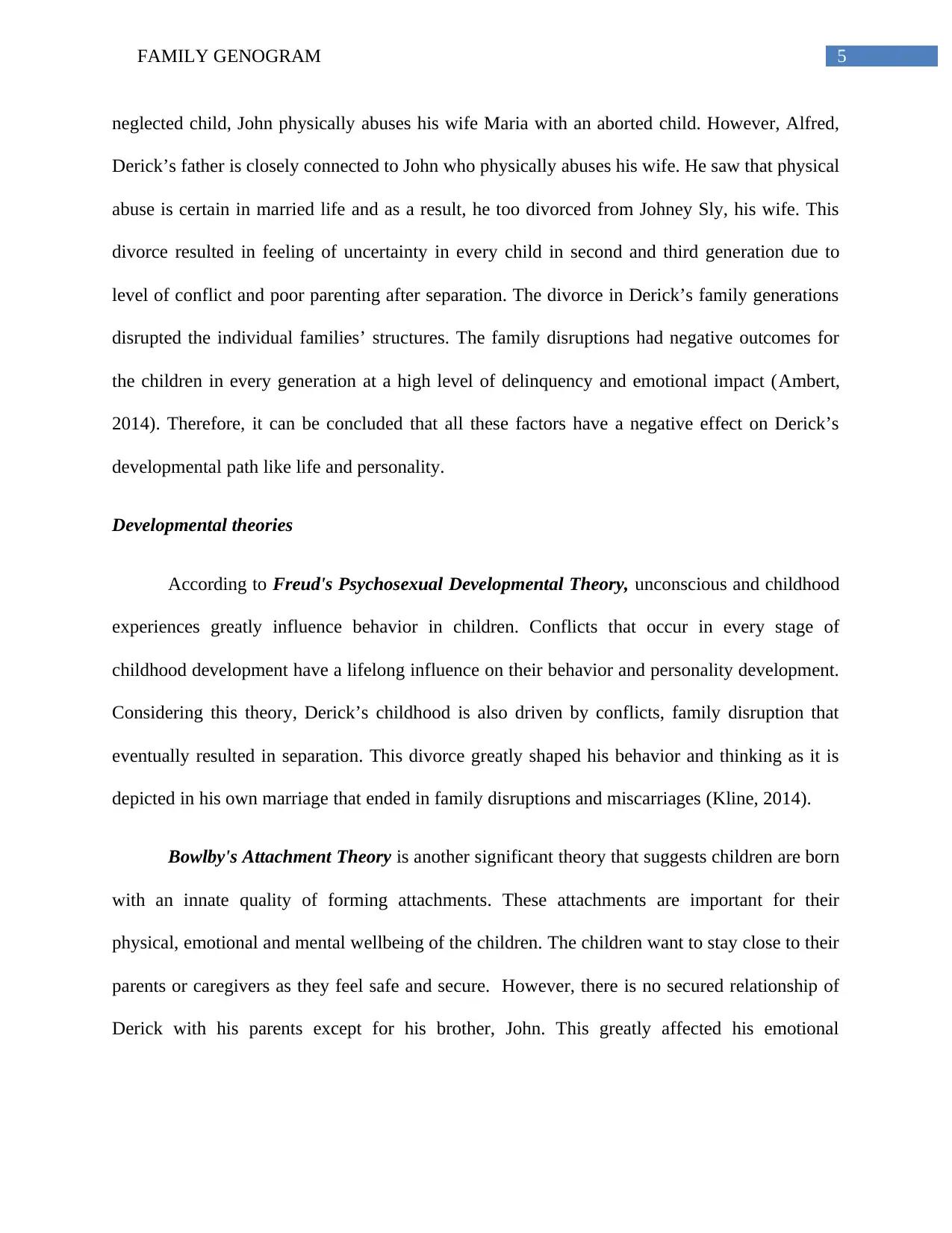
5FAMILY GENOGRAM
neglected child, John physically abuses his wife Maria with an aborted child. However, Alfred,
Derick’s father is closely connected to John who physically abuses his wife. He saw that physical
abuse is certain in married life and as a result, he too divorced from Johney Sly, his wife. This
divorce resulted in feeling of uncertainty in every child in second and third generation due to
level of conflict and poor parenting after separation. The divorce in Derick’s family generations
disrupted the individual families’ structures. The family disruptions had negative outcomes for
the children in every generation at a high level of delinquency and emotional impact (Ambert,
2014). Therefore, it can be concluded that all these factors have a negative effect on Derick’s
developmental path like life and personality.
Developmental theories
According to Freud's Psychosexual Developmental Theory, unconscious and childhood
experiences greatly influence behavior in children. Conflicts that occur in every stage of
childhood development have a lifelong influence on their behavior and personality development.
Considering this theory, Derick’s childhood is also driven by conflicts, family disruption that
eventually resulted in separation. This divorce greatly shaped his behavior and thinking as it is
depicted in his own marriage that ended in family disruptions and miscarriages (Kline, 2014).
Bowlby's Attachment Theory is another significant theory that suggests children are born
with an innate quality of forming attachments. These attachments are important for their
physical, emotional and mental wellbeing of the children. The children want to stay close to their
parents or caregivers as they feel safe and secure. However, there is no secured relationship of
Derick with his parents except for his brother, John. This greatly affected his emotional
neglected child, John physically abuses his wife Maria with an aborted child. However, Alfred,
Derick’s father is closely connected to John who physically abuses his wife. He saw that physical
abuse is certain in married life and as a result, he too divorced from Johney Sly, his wife. This
divorce resulted in feeling of uncertainty in every child in second and third generation due to
level of conflict and poor parenting after separation. The divorce in Derick’s family generations
disrupted the individual families’ structures. The family disruptions had negative outcomes for
the children in every generation at a high level of delinquency and emotional impact (Ambert,
2014). Therefore, it can be concluded that all these factors have a negative effect on Derick’s
developmental path like life and personality.
Developmental theories
According to Freud's Psychosexual Developmental Theory, unconscious and childhood
experiences greatly influence behavior in children. Conflicts that occur in every stage of
childhood development have a lifelong influence on their behavior and personality development.
Considering this theory, Derick’s childhood is also driven by conflicts, family disruption that
eventually resulted in separation. This divorce greatly shaped his behavior and thinking as it is
depicted in his own marriage that ended in family disruptions and miscarriages (Kline, 2014).
Bowlby's Attachment Theory is another significant theory that suggests children are born
with an innate quality of forming attachments. These attachments are important for their
physical, emotional and mental wellbeing of the children. The children want to stay close to their
parents or caregivers as they feel safe and secure. However, there is no secured relationship of
Derick with his parents except for his brother, John. This greatly affected his emotional
⊘ This is a preview!⊘
Do you want full access?
Subscribe today to unlock all pages.

Trusted by 1+ million students worldwide
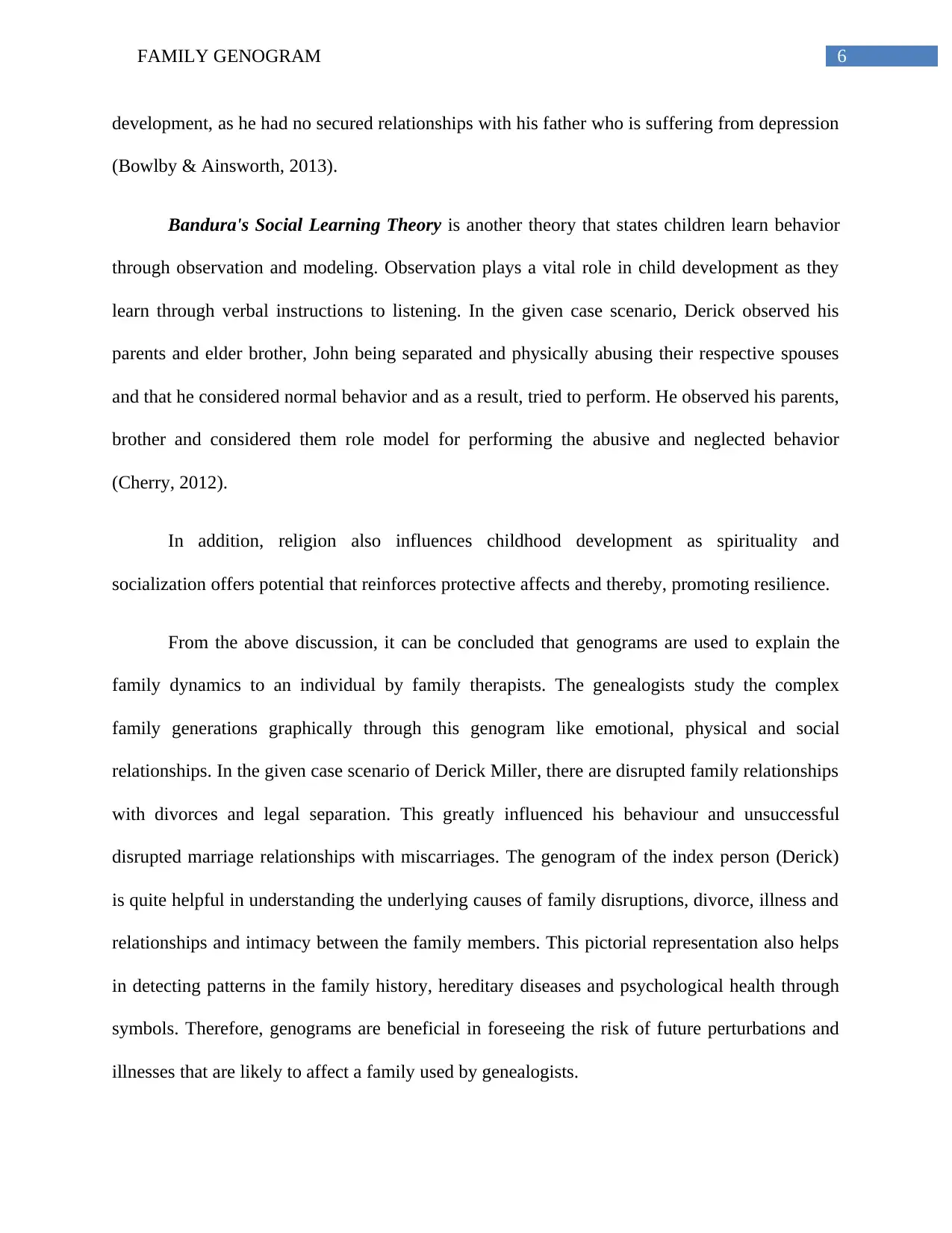
6FAMILY GENOGRAM
development, as he had no secured relationships with his father who is suffering from depression
(Bowlby & Ainsworth, 2013).
Bandura's Social Learning Theory is another theory that states children learn behavior
through observation and modeling. Observation plays a vital role in child development as they
learn through verbal instructions to listening. In the given case scenario, Derick observed his
parents and elder brother, John being separated and physically abusing their respective spouses
and that he considered normal behavior and as a result, tried to perform. He observed his parents,
brother and considered them role model for performing the abusive and neglected behavior
(Cherry, 2012).
In addition, religion also influences childhood development as spirituality and
socialization offers potential that reinforces protective affects and thereby, promoting resilience.
From the above discussion, it can be concluded that genograms are used to explain the
family dynamics to an individual by family therapists. The genealogists study the complex
family generations graphically through this genogram like emotional, physical and social
relationships. In the given case scenario of Derick Miller, there are disrupted family relationships
with divorces and legal separation. This greatly influenced his behaviour and unsuccessful
disrupted marriage relationships with miscarriages. The genogram of the index person (Derick)
is quite helpful in understanding the underlying causes of family disruptions, divorce, illness and
relationships and intimacy between the family members. This pictorial representation also helps
in detecting patterns in the family history, hereditary diseases and psychological health through
symbols. Therefore, genograms are beneficial in foreseeing the risk of future perturbations and
illnesses that are likely to affect a family used by genealogists.
development, as he had no secured relationships with his father who is suffering from depression
(Bowlby & Ainsworth, 2013).
Bandura's Social Learning Theory is another theory that states children learn behavior
through observation and modeling. Observation plays a vital role in child development as they
learn through verbal instructions to listening. In the given case scenario, Derick observed his
parents and elder brother, John being separated and physically abusing their respective spouses
and that he considered normal behavior and as a result, tried to perform. He observed his parents,
brother and considered them role model for performing the abusive and neglected behavior
(Cherry, 2012).
In addition, religion also influences childhood development as spirituality and
socialization offers potential that reinforces protective affects and thereby, promoting resilience.
From the above discussion, it can be concluded that genograms are used to explain the
family dynamics to an individual by family therapists. The genealogists study the complex
family generations graphically through this genogram like emotional, physical and social
relationships. In the given case scenario of Derick Miller, there are disrupted family relationships
with divorces and legal separation. This greatly influenced his behaviour and unsuccessful
disrupted marriage relationships with miscarriages. The genogram of the index person (Derick)
is quite helpful in understanding the underlying causes of family disruptions, divorce, illness and
relationships and intimacy between the family members. This pictorial representation also helps
in detecting patterns in the family history, hereditary diseases and psychological health through
symbols. Therefore, genograms are beneficial in foreseeing the risk of future perturbations and
illnesses that are likely to affect a family used by genealogists.
Paraphrase This Document
Need a fresh take? Get an instant paraphrase of this document with our AI Paraphraser
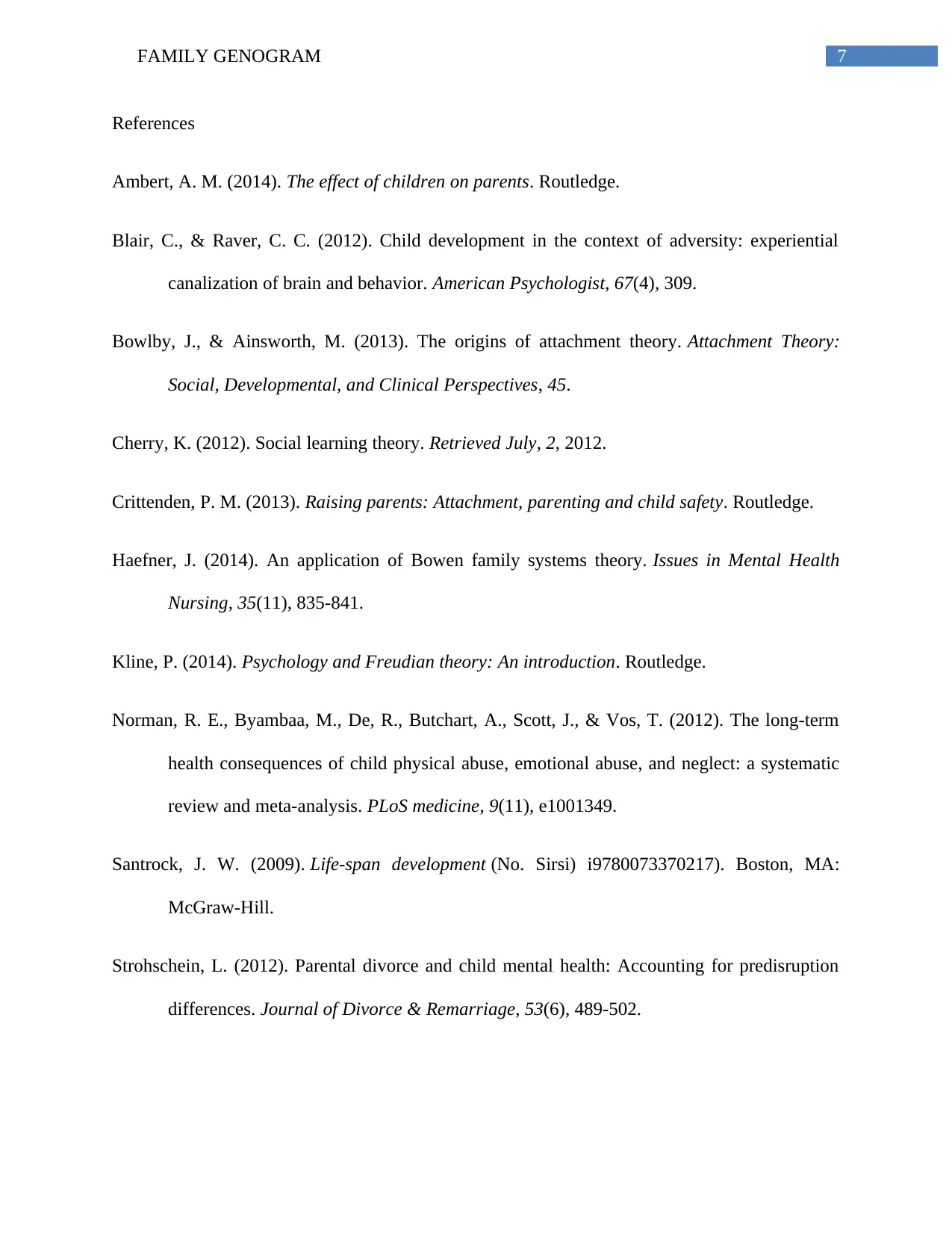
7FAMILY GENOGRAM
References
Ambert, A. M. (2014). The effect of children on parents. Routledge.
Blair, C., & Raver, C. C. (2012). Child development in the context of adversity: experiential
canalization of brain and behavior. American Psychologist, 67(4), 309.
Bowlby, J., & Ainsworth, M. (2013). The origins of attachment theory. Attachment Theory:
Social, Developmental, and Clinical Perspectives, 45.
Cherry, K. (2012). Social learning theory. Retrieved July, 2, 2012.
Crittenden, P. M. (2013). Raising parents: Attachment, parenting and child safety. Routledge.
Haefner, J. (2014). An application of Bowen family systems theory. Issues in Mental Health
Nursing, 35(11), 835-841.
Kline, P. (2014). Psychology and Freudian theory: An introduction. Routledge.
Norman, R. E., Byambaa, M., De, R., Butchart, A., Scott, J., & Vos, T. (2012). The long-term
health consequences of child physical abuse, emotional abuse, and neglect: a systematic
review and meta-analysis. PLoS medicine, 9(11), e1001349.
Santrock, J. W. (2009). Life-span development (No. Sirsi) i9780073370217). Boston, MA:
McGraw-Hill.
Strohschein, L. (2012). Parental divorce and child mental health: Accounting for predisruption
differences. Journal of Divorce & Remarriage, 53(6), 489-502.
References
Ambert, A. M. (2014). The effect of children on parents. Routledge.
Blair, C., & Raver, C. C. (2012). Child development in the context of adversity: experiential
canalization of brain and behavior. American Psychologist, 67(4), 309.
Bowlby, J., & Ainsworth, M. (2013). The origins of attachment theory. Attachment Theory:
Social, Developmental, and Clinical Perspectives, 45.
Cherry, K. (2012). Social learning theory. Retrieved July, 2, 2012.
Crittenden, P. M. (2013). Raising parents: Attachment, parenting and child safety. Routledge.
Haefner, J. (2014). An application of Bowen family systems theory. Issues in Mental Health
Nursing, 35(11), 835-841.
Kline, P. (2014). Psychology and Freudian theory: An introduction. Routledge.
Norman, R. E., Byambaa, M., De, R., Butchart, A., Scott, J., & Vos, T. (2012). The long-term
health consequences of child physical abuse, emotional abuse, and neglect: a systematic
review and meta-analysis. PLoS medicine, 9(11), e1001349.
Santrock, J. W. (2009). Life-span development (No. Sirsi) i9780073370217). Boston, MA:
McGraw-Hill.
Strohschein, L. (2012). Parental divorce and child mental health: Accounting for predisruption
differences. Journal of Divorce & Remarriage, 53(6), 489-502.
1 out of 8
Your All-in-One AI-Powered Toolkit for Academic Success.
+13062052269
info@desklib.com
Available 24*7 on WhatsApp / Email
![[object Object]](/_next/static/media/star-bottom.7253800d.svg)
Unlock your academic potential
Copyright © 2020–2025 A2Z Services. All Rights Reserved. Developed and managed by ZUCOL.


